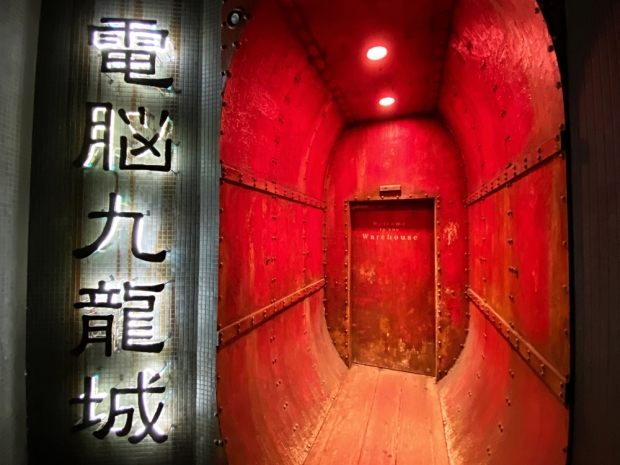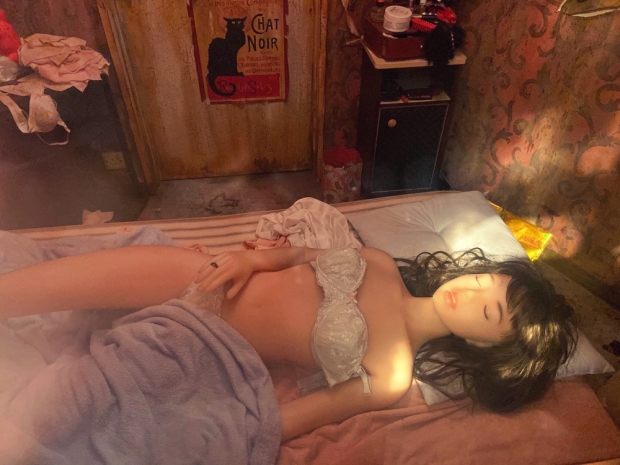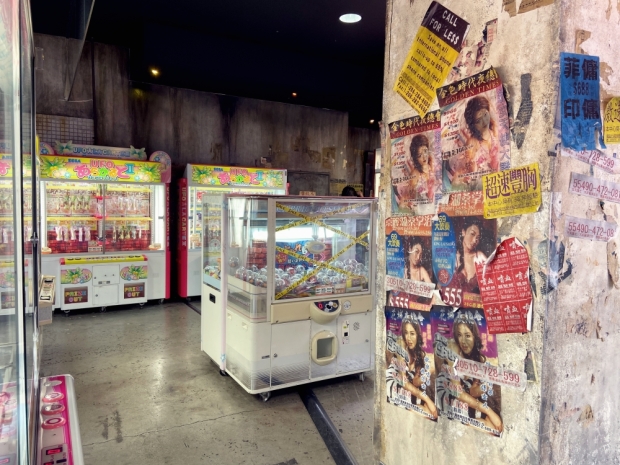Brightly lit neon video arcades are ubiquitous in Japan—but there was one special one I had to visit. I came across the Anata No Warehouse by accident, I don’t quite remember how, but it’s very likely that it was featured on some “weird shit you’ll find in Japan”-list or other when I was researching things to do around Tokyo. Seeing a couple of pictures was enough to have us sold, and we took a train to Kawasaki for the sole purpose of going to this one of a kind dystopian/cyberpunk/Kowloon Walled City themed arcade.

About twenty minutes from Tokyo by train, and barely a ten minute walk from the Kawasaki station, the five-story Anata No Warehouse was hard to overlook: Amid all the other sleek and modern buildings nearby, the Warehouse’s faux rusted sheet metal exterior stuck out like a sore thumb. The arcade was the perhaps most elaborately themed one in the country (the world?), and even with the exterior, they weren’t playing around, and the attention to detail was astounding.
You may have noticed that I’m referring to it in the past tense. Unfortunately, it permanently closed its doors on November 17th, 2019, after having pretty much become a cult location in the past decade. The reasons it ceased business weren’t disclosed, but we consider ourselves extremely lucky as far as our timing went. We had it planned as an anniversary activity, which would’ve fallen on the 24th of November—too late. We visited on the spur of the moment a week prior to it closing because we had spare time in our day, completely oblivious to the fact that it was about to shut down for good!

Once you stepped through the rusted iron doors, you found yourself in a dark, futuristic-looking passageway lit by just a few light bulbs, bathing everything in a soft red glow. In this first part, I felt like I was in a spaceship. The next rusty door welcomes you to the Warehouse, and when that slid open, you found yourself in a maze of faux-grimy alleys, meant to transport you back to the Kowloon Walled City in Hong Kong (the real thing has been demolished for thirty years).
The arcade was 18+, and it was soon clear why: To the left of the main entrance, there was a dirty window that offered a view into a seedy room complete with sex doll. Walking along the narrow alleyway towards the back, under exposed electrical wires and grimy pipes, ads with pouting prostitutes covered the moisture-stained walls, along with ones for shady medical services. Pertinent sound effects were played seemingly in the distance, adding to the illusion of being lost in some seedy back alley, while unseen people were hidden behind grimy windows and dripping walls. The elevators were so believably rusted and grubby that we opted for the escalators instead.

Before exploring the upper floors, where the arcade games are located, we ventured to the very back, where the arcade’s inside theme breaks, recalling instead the entrance passageway: The back exit was reached through an octagonal tunnel (bathed in the same soft red light) which opened into a straight-up sci-fi fantasy room complete with a misty and unhealthily colored pool you had to traverse via stepping stones with rusty railings on both sides, dragon heads on the walls, and extraterrestrial-looking symbols around the mouth of the tunnel. The outside door opened into the car park and had a yin yang symbol on it.
We decided to start on the top floor and work our way down. The fifth floor was members only, and we couldn’t see past the reception area—every surface was carpeted in a gross pinkish color, and the only people we saw were middle-aged business men in suits. The fourth floor had a fake Roman fountain and was otherwise a regular-looking, vast and smoky expanse of darts and billiard tables. The third floor wasn’t very interesting to us either—this is where the games you usually find in casinos were located. They had the classic coin pushers and slot machines (how depressing to see Japan’s very real gambling problem first-hand, with mothers holding their children on their lap as they threw in coin after coin), but also a virtual horse race on a huge screen, and sports betting areas. We used the restrooms here, which kept in the theme of grimy Kowloon by being covered in fake filth (but they were actually pretty immaculate—it’s hard to explain how that’s even possible).

This medal-games floor is where we caught the first glimpse of the recreated Kowloon Walled City from above. The attention to detail here is staggering; the signs were hand-painted to look authentic, and the designers supposedly imported props and trash directly from Hong Kong. Before being demolished in the early 90’s, the Kowloon Walled City was an ungoverned, densely populated settlement slum, infamous for its dense architecture, horrible living conditions, and sky high rates of prostitution, gambling, and drug abuse. It’s no surprise that the city was the inspiration for many dystopian films, such as Blade Runner—the alleyways were rarely wider than two meters, and the city could be traversed via a network of passageways and stairways on upper levels, so that you never touched the ground. This had been recreated well at Anata No Warehouse, where, much like in the real city, no natural sunlight filtered through. It really gave you a sense of suffocating urbanization, all while hundreds of video games and slot machines added their jingles to one big cacophony of nightmarish sound.
The second floor is where the good stuff is. Unfortunately, the games that appealed to us seemed to all be out of order (Mario Kart, air hockey,…), which should’ve tipped us off to the fact that the Warehouse wouldn’t be around for much longer. We played a few games of Tetris, where you would rotate the tiles by twisting a huge joystick, and a two-player-version of PacMan. The rest of our time, we spent checking out the many retro games, observing other people who were clearly pros at what they were doing, and marveling at the contents of the claw machines… you could grab just about everything, from laundry detergent, ramen, minions merch, hot sauce, to seemingly hundreds of different sexualised plastic figurines.

In retrospect, we should’ve worked our way up, as the Kowloon immersion would’ve worked better that way. We weren’t the only ones attracted to the Warehouse because of its unique theme; we spotted many tourists (mostly Japanese, actually) with big cameras slung around their necks, who spent more time taking pictures and marveling at the props than playing games, if they did that at all. I’m sad that it closed, but grateful that I got to visit before it did, since this was exactly my brand of weird as fuck.









This sounds so cool! I’m glad you got to make it before it closed.
LikeLiked by 1 person
So am I!! I couldn’t believe my luck when I read up on it in the train right after visiting and it said that it would close a week later. What are the odds! Had we kept to our original plans, we would’ve stood in front of closed doors, and what a disappointing anniversary that would’ve been!!
LikeLiked by 1 person